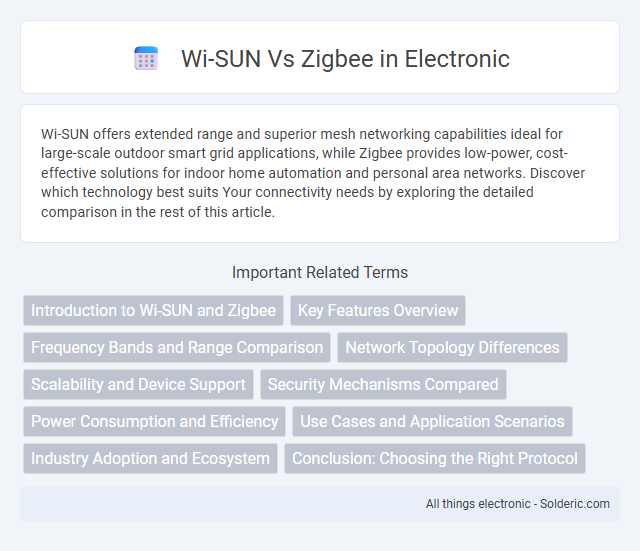Wi-SUN offers extended range and superior mesh networking capabilities ideal for large-scale outdoor smart grid applications, while Zigbee provides low-power, cost-effective solutions for indoor home automation and personal area networks. Discover which technology best suits Your connectivity needs by exploring the detailed comparison in the rest of this article.
Comparison Table
| Feature | Wi-SUN | Zigbee |
|---|---|---|
| Standard | IEEE 802.15.4g | IEEE 802.15.4 |
| Range | Up to 10 km (mesh network) | Up to 100-300 meters |
| Frequency | Sub-GHz bands (e.g., 900 MHz) | 2.4 GHz ISM band |
| Data Rate | 50-300 kbps | 20-250 kbps |
| Network Topology | Mesh, multi-hop | Mesh, star, tree |
| Power Consumption | Low power, optimized for battery | Very low power, suitable for battery devices |
| Security | 128-bit AES encryption | 128-bit AES encryption |
| Use Cases | Smart grid, smart meters, utility networks | Home automation, lighting, sensor networks |
| Interoperability | High with multiple vendors, open standards | Wide device ecosystem, extensive vendor support |
Introduction to Wi-SUN and Zigbee
Wi-SUN and Zigbee are prominent wireless communication protocols designed for smart grid and IoT applications, emphasizing low power consumption and reliable mesh networking. Wi-SUN operates primarily in sub-GHz frequency bands, offering long-range connectivity suitable for large-scale outdoor deployments, while Zigbee typically uses the 2.4 GHz band, favored for short-range, low-data-rate, indoor environments. Your choice between Wi-SUN and Zigbee depends on factors such as network size, range requirements, and interoperability within your smart home or industrial ecosystem.
Key Features Overview
Wi-SUN offers robust mesh networking with long-range communication and high scalability, making it ideal for smart utility networks and outdoor environments. Zigbee emphasizes low power consumption, interoperability, and secure communication within short-range wireless personal area networks, commonly used in home automation. Both protocols support mesh topologies but differ in range, power usage, and target applications, with Wi-SUN optimized for wide-area deployments and Zigbee for localized device connectivity.
Frequency Bands and Range Comparison
Wi-SUN operates primarily in sub-GHz frequency bands such as 902-928 MHz, offering extended range capabilities up to several kilometers in outdoor environments. Zigbee utilizes the 2.4 GHz band, which supports shorter ranges typically around 10-100 meters indoors due to higher signal attenuation. Your choice depends on whether long-distance communication (Wi-SUN) or higher data throughput in close proximity (Zigbee) better suits your network requirements.
Network Topology Differences
Wi-SUN employs a mesh network topology that allows numerous nodes to communicate directly or via multiple hops, providing high scalability and resilient connectivity ideal for large-scale smart grid and utility applications. Zigbee also uses a mesh topology but primarily supports smaller, low-power device networks, optimized for home automation and IoT devices with limited node counts. Wi-SUN's dynamic routing and self-healing capabilities outperform Zigbee in complex outdoor environments, while Zigbee excels in environments requiring low latency and energy-efficient communication.
Scalability and Device Support
Wi-SUN offers superior scalability compared to Zigbee, supporting thousands of devices in large mesh networks ideal for smart city and utility applications. Zigbee is designed for smaller-scale networks, typically supporting up to a few hundred devices, making it suitable for home automation and localized smart environments. Your choice depends on the network size and device density requirements, with Wi-SUN excelling in extensive, high-density deployments.
Security Mechanisms Compared
Wi-SUN employs advanced AES-128 encryption with robust key management protocols and supports PKI-based authentication, enhancing network confidentiality and integrity in large-scale utility and smart city deployments. Zigbee uses AES-128 encryption as well but relies primarily on shared link keys for device authentication, which can be vulnerable without proper key distribution practices in smaller-scale home automation environments. The Wi-SUN Alliance emphasizes mutual authentication and secure firmware updates, offering superior protection against network attacks compared to Zigbee's more straightforward security model.
Power Consumption and Efficiency
Wi-SUN offers superior power efficiency for outdoor and large-scale smart grid applications due to its low power consumption and adaptive mesh networking capabilities. Zigbee excels in home automation with minimal energy use during intermittent communication, optimizing power for battery-operated devices. Your choice should align with the specific power demands and network size of your smart environment.
Use Cases and Application Scenarios
Wi-SUN excels in large-scale outdoor smart city networks, smart metering, and industrial automation due to its robust mesh networking and long-range communication capabilities. Zigbee is ideal for indoor smart home automation, lighting control, and small-scale IoT deployments, benefiting from low power consumption and widespread device compatibility. Both protocols support IoT connectivity but serve distinct application scenarios based on range, scalability, and environmental requirements.
Industry Adoption and Ecosystem
Wi-SUN boasts strong industry adoption in smart utility networks, with a robust ecosystem supported by major utilities and regulatory bodies, enabling large-scale, interoperable deployments for smart metering and grid management. Zigbee benefits from widespread adoption across consumer smart home applications, backed by a mature ecosystem of device manufacturers, extensive developer tools, and broad compatibility with IoT platforms. The Wi-SUN Alliance and Zigbee Alliance each foster innovation and certification processes, but Wi-SUN focuses more on outdoor, large-area networks, whereas Zigbee dominates indoor, low-power device interoperability.
Conclusion: Choosing the Right Protocol
Selecting between Wi-SUN and Zigbee depends on your network's range and scalability needs, with Wi-SUN excelling in large-scale, outdoor smart city applications due to its robust mesh networking and long-range capabilities. Zigbee offers advantages in low-power, short-range indoor environments ideal for home automation and consumer electronics. Your choice should align with the specific deployment environment and device interoperability requirements.
Wi-SUN vs Zigbee Infographic

 solderic.com
solderic.com